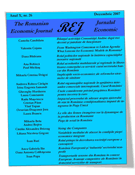Abstract:
The educational system worldwide is currently under the spotlight as it shows significant signs of an ongoing crisis in its search for resources, visibility in the crowded market and significance to the ever-changing society. Within this framework, higher education institutions (HEIs) are taking significant actions for maintaining students as clients of their educational services. As competition on this market is becoming stronger, HEIs face difficulties in keeping students, leading them to a continuous evaluation of student satisfaction indicators. Beyond HEIs’ managers, researchers in marketing higher education have contributed to the development of a comprehensive literature where still very few have forwarded a longitudinal research model for student satisfaction evaluation despite the need for such approaches. Given this context, the current paper presents a first step towards a longitudinal study as it displays, in a compare and contrast vision, the results of two different quantitative research projects developed in the same student community, with the same objective, but conducted in two different years. Among the most significant results of this research refer to an important decline in students’ satisfaction with a significant increase in the number of students that have a neutral perception. This is highly expected to determine a major impact on university’s overall performance and, therefore, it constitutes a strong argument for determining underlying causes, and especially developing the appropriate marketing strategies to tackle with these issues. Based on this result and other similar research outcomes, strategic and tactic recommendations are granted in the final part of this paper.
